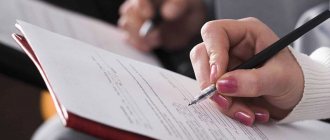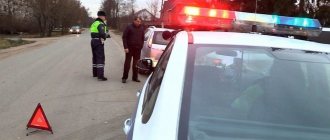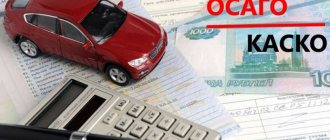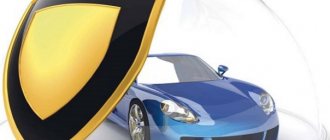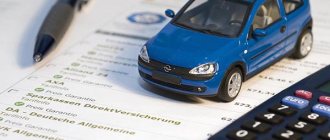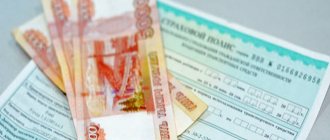Road accidents are not uncommon today and happen every day, so many are interested in the procedure for recovering damages from the culprit of the accident. Although under current insurance policies the insurer undertakes to reimburse the expenses incurred, in reality this rarely happens.
Because the company is trying in every possible way to find a reason not to pay anything. In such a situation, covering the costs by the real culprit of the incident is most fair and is supported by the position of the legislator. The article will tell you how to get funds, illustrate real situations from judicial practice and other important nuances that you should pay attention to.
Covering damage is the insurer's obligation
Reimbursement of the finances necessary for the restoration of both the vehicle and the victim after an accident is entrusted to the insurance company that issued the compulsory motor liability insurance policy to the person responsible for the accident.
The amounts of compensation in accordance with Article 7 of Federal Law No. 40 “On Compulsory Civil Liability Insurance” are quite limited:
- Up to 500 thousand for physical harm - damage, injury, death.
- Up to 400 thousand according to the property factor.
However, it is sometimes difficult to obtain these amounts from the insurer. As a rule, the reasons for refusal are:
- the driver at fault was drunk at the time of the accident;
- not having a driver's license with you;
- the commission of an accident during a period not specified in the insurance document;
- when the accident occurred, you did not have the insurance policy with you;
- expiration of the institution's license.
The listed factors are not considered legal. In the first two situations, the company reimburses the costs and subsequently has the right to go to court with a counterclaim against the culprit. If the document is not available at the time of the incident, the necessary information is subsequently established and payment is made. Upon expiration of the permission for the organization to carry out its activities, all claims are accepted by the RSA (Union of Automobile Insurers).
In a car accident, the burden of compensation falls on the driver in the following circumstances:
- The amount of the amount exceeds the established limit (then the refund is made according to the amount of the difference).
- The damage was not caused while moving (unsuccessful opening of the door while parked).
- Moral damage to injured participants.
- Lack of insurance (many people really neglect the established rule. Thus, court decisions in 2021 without compulsory motor liability insurance once again prove the unprofitability of not having a policy at all. Isaeva A. filed a petition with the court for reimbursement of the expenses she had incurred from the culprit of the car accident, Novikov. In 2021 at 17.00 an accident occurred on the M4 highway - a Ford crashed into another foreign car. An examination was carried out on the fact and it was established that, taking into account wear and tear, material costs would amount to 200 thousand rubles, but the plaintiff in her application asked for compensation without taking into account wear and tear. The court ruled that Novikov was guilty of commission of the act and will be punished in the form of a refund to the applicant based on the costs of restoring the car, paying an expert, as well as legal costs.
When insurance doesn't work
If a participant in an accident, who is the injured party, has a compulsory motor liability insurance policy, but the provided limit is not enough to compensate for the damage caused, the remaining amount must be paid by the culprit of the incident. The limit for covering costs associated with the repair and restoration of a vehicle is 400 thousand rubles. Compensation for damage caused to the health of one of the participants in an accident can be assessed by the insurance company at a maximum of 500 thousand rubles. If, following an accident, a so-called European report is drawn up (traffic police officers are not called to the scene of the accident), the insurance company will compensate up to 25 thousand rubles. In addition, the insurance company may refuse compensation for damage if it is determined that the accident does not qualify as an insured event.
If the parties to the accident came to a peaceful resolution and agreed to settle the situation without the participation of the insurance company, the victim must give the culprit a receipt stating that he has no claims against the latter. However, if there are still claims, such a receipt cannot be written under any circumstances, since then it will be impossible to receive compensation. If the culprit refuses to compensate for the damage, the victim has every reason to go to court.
If the culprit has drawn up a receipt indicating the terms of compensation, such a receipt may be valid if it is certified by a notary.
What can be recovered
When filing a statement of claim or drawing up the text of a settlement agreement, you need to be extremely careful when working out the “requirements” clause. For example, as judicial practice shows, requests are not satisfied without taking into account the wear and tear of the vehicle. Because in this case, the owner seeks not only to return the funds spent on repairs due to an accident, but also to completely restore the car at someone else’s expense (to repair faults that prevent comfortable use even before the accident). This position of the owner is not welcome.
From the guilty individual, the victim has the right to receive:
- compensation for repair costs taking into account wear and tear (until recently, court decisions without wear and tear of OSAGO had a negative trend. However, the Constitutional Court clarified that the difference between the amount paid by the insurer will be paid independently by the culprit. In fact, most of the costs will have to be compensated by the defendants);
- costs for towing and car storage;
- loss of the commodity price of the vehicle. The calculation is made if the period of use of the machine is less than 5 years, the estimated wear and tear does not exceed 35%;
- moral damage in the event of physical and moral suffering of the victim (regulated by Article 1100 of the Civil Code of the Russian Federation. It is assumed regardless of the presence of culpable motives on the part of the perpetrator, but upon the fact of infliction by a source of increased danger, which, according to the provisions of Article 1079 of the Code, includes vehicles);
- compensation of wages for the entire period of time during which a person is unable to work;
- expenses for a representative in court, postage, examination and others.
If damage is caused to a person’s health, an extract from the medical record and a medical examination report determining the severity of the damage caused must be provided as evidence. In addition, you should provide documents indicating expenses - prescriptions, payment receipts from the pharmacy, etc.
Responsibility of the car owner in case of an accident
When criminal liability arises for the owner of a vehicle in an accident.
If the accident caused harm to human life or health, a number of measures will be taken against the culprit of the accident.
In Art. 264 and Art. 264.1 of the Criminal Code of the Russian Federation talks about crimes related to violation of traffic rules and the use of vehicles.
Aggravating circumstances in an accident, according to Art. 63 of the Criminal Code of the Russian Federation, recognized:
- driving while intoxicated;
- as a result of the accident, people died (two or more people);
- the driver who caused the accident had previously been brought to administrative responsibility.
An intentional act while driving a car that led to the death of the victim is equivalent to murder (Article 105 of the Criminal Code of the Russian Federation). If a person has suffered grievous harm to health, the actions of the perpetrator are qualified as intentional infliction of grievous harm to health (Article 11 of the Criminal Code of the Russian Federation).
If the driver and the owner of the car are not the same person, then the citizen who was driving the car at the time of the accident will be responsible for the violation.
According to Art. 5 of the Criminal Code of the Russian Federation, the culprit of the crime will be the person who drove the vehicle and hit a pedestrian, caused a collision between cars, etc. It does not matter whether this person is the owner of the vehicle.
Only an individual can be the subject of a socially dangerous act.
When the administrative responsibility of the car owner arises in the event of an accident.
One of the chapters of the Code of Administrative Offenses of the Russian Federation (Chapter 12) is entirely devoted to violations of traffic rules and the participation of citizens in road accidents. So in Art. 12.24 of the Code of Administrative Offenses of the Russian Federation states that the object of the offense in an accident is the infliction of light or moderate harm to the health of a participant in the accident.
To determine the extent of harm, it is necessary to undergo a medical examination (examination).
In accordance with administrative legislation, the participant in the accident who is found guilty will be responsible for a traffic crime (Article 1.5 of the Code of Administrative Offenses of the Russian Federation).
According to the law, the driver of a vehicle who created an emergency situation and, as a result of his actions or inaction, an accident occurred is considered guilty.
Sometimes the guilt of the car owner is determined based on the testimony of video and photo surveillance cameras that recorded the accident (Article 2.6.1 of the Code of Administrative Offenses of the Russian Federation). The fact is that by looking at such photographs, you can identify the car, and not the person who drove it. Therefore, the direct owner of the vehicle automatically becomes the culprit.
The exception is the case when the owner manages to absolutely prove his non-involvement in the accident.
If you think that by presenting the vehicle purchase and sale agreement as evidence, you will be able to prove your non-involvement in the accident, you are mistaken.
The existence of this agreement does not mean that at the time of the accident the owner of the car had already changed. This may be the case if at the time of the accident the new owner had not yet managed to re-register the car.
If the car is sold and a corresponding agreement has been drawn up, but re-registration has not been completed within 10 days after the sale, the responsibility for deregistering the car passes to you.
A legal entity does not bear administrative responsibility for an accident.
In what case does the vehicle owner have civil liability in the event of a traffic accident?
What is civil liability in case of an accident?
In this case, we are talking about compensation for material and moral damage to victims of the accident.
The Civil Code of the Russian Federation states that the operation of a vehicle is an activity that creates an increased danger for other citizens (Article 1079 of the Civil Code of the Russian Federation).
The owner of the car is responsible for compensating the victims. The only exception is the situation when he manages to prove that at the time of the accident such circumstances arose that he was unable to overcome.
A legal entity that owns a vehicle that caused an accident also bears civil liability, just like an individual.
The owner of a car can be not only a person who has legal grounds to do so. The owner of a car who is not included in the vehicle’s passport, but operates it on a rental basis, with a power of attorney or by order, also bears civil liability for an accident. That is, at the time of the accident he is recognized as the legal owner of the vehicle.
At what age do drivers bear civil liability in case of an accident?
In accordance with the law, civil liability for violating traffic rules begins at the age of 14. If the driver responsible for the accident was a teenager under 14 years of age, responsibility is transferred to his legal representatives. First of all, they are parents (Article 1073 of the Civil Code of the Russian Federation).
If the driver was already 14 years old at the time of the accident, he is liable for compensation for damage to victims on a general basis (Article 1074 of the Civil Code of the Russian Federation).
If at this age the person responsible for the accident does not have any income and, therefore, has nothing to compensate for the damage, his parents or other legal representatives assume his responsibilities.
These persons may be released from such liability if they prove the complete absence of their guilt in this offense.
When is a car owner released from civil liability?
In Art. 1079 of the Civil Code of the Russian Federation lists cases when the owner of a vehicle is released from his obligations to compensate for damage:
- the presence of extraordinary or unavoidable circumstances. That is, if force majeure circumstances arose that were not possible to overcome;
- the victim’s actions were intentional, that is, he foresaw and accordingly allowed the accident to occur;
- the owner was not able to operate the vehicle, since it was no longer in his possession (hijacking, theft of the vehicle). In this case, you will need reasonable proof of the fact that the car was stolen and it is not the owner’s fault.
When are the culprit of an accident and the owner of the vehicle jointly and severally liable?
This situation occurs quite rarely, therefore it is an atypical civil liability of a group of persons.
In this case, the injured party has the right to choose the person who will compensate it for the damage resulting from the accident. Also, this responsibility can be borne simultaneously by both the driver and the owner.
According to Art. 1079 of the Civil Code of the Russian Federation, the primary fault is the fault of the driver who was driving the car at the time of the accident.
In a situation where the car left the owner’s possession due to his own fault (left the car unattended with the keys, etc.), and if this fact is confirmed, the owner will have to bear responsibility together with the culprit of the accident on a shared basis.
In this case, everything will depend on the degree of guilt of each of the persons responsible in this situation.
Joint and several liability in the classic version occurs when there were several participants in the accident. Owners of these vehicles, in accordance with clause 3 of Art. 1079 of the Civil Code of the Russian Federation will bear group liability.
When the culprit of the accident died, or if a minor was driving, the lessee of the vehicle, an employee of the organization, or the owner of the car will bear joint liability if his guilt is proven.
The owner of the accident also becomes liable if the person responsible for the accident flees the scene of the accident.
Compensation by agreement of the parties
It is better to return funds for restoration by mutual agreement and good will, which happens extremely rarely, especially when it comes to large amounts of payments.
Before contacting the culprit, the individual undertakes to follow the following algorithm of actions:
- Have the necessary documents from the traffic police on hand.
- Visit the insurer (receive an amount of compensation that is clearly less than the actual amount of expenses or even hear an official refusal).
- Conduct an independent examination.
- And only at this stage start conversations with the other side.
The start of negotiations should be considered the submission of a claim with the following content:
- information about the culprit of the car accident;
- information about what happened;
- information about the damaged vehicle;
- results of the examination;
- the total amount of damage caused;
- the amount of payments transferred by the insurance company;
- the difference between the insurance premium and the actual damage;
- amount of payment from the culprit;
- contacts of the applicant for dialogue (address, telephone, e-mail).
IMPORTANT !!! When drawing up a document, you need to indicate in it a reasonable period for the return of funds, as well as the expected form of payment - in person in cash against a receipt or by bank transfer to the specified details.
All duplicates of documentation should be attached to the claim letter for the other party to review, namely:
- Act on the occurrence of an insured event.
- Resolution on the case of an administrative offense from the traffic police.
- Notice with a call for inspection.
- Expert opinion.
- Checks, receipts, service agreements.
It is recommended that the claim and paper support be sent by a valuable letter with a list of the attachments, as well as with a return receipt (which is subsequently attached in the event of litigation to other documents). You should also remember such important points as: no wear, compulsory insurance, court decisions.
Action steps:
1. Notification of the insurance company about the accident. The period for notifying the insurance company about the occurrence of an insured event is 5 working days from the moment of the accident, however, this period is not final.
2. Receiving documents from the traffic police. The most important stage in compensating for damage after an accident is collecting documents. You must be sure that you have received all the documents from the traffic police, which in the future will be a key factor both in the insurance company and in the court. The traffic police must give you a copy of the protocol on an administrative offense, a resolution in a case of an administrative offense, or a ruling refusing to initiate a case on an administrative offense.
3. Independent examination. It is worth initially thinking about conducting a paid independent examination before the insurance company assesses the damage, this will speed up the process of compensation for damage. Choose an appraisal organization yourself and enter into a service agreement with it, then the specialists will act independently.
Please note that the cost of damage assessment services is included in the insurance compensation or as payment for material damage by the person at fault for the accident.
What to check:
- execution of an agreement for the provision of damage assessment services - it must be carried out in accordance with the requirements of current legislation - have the necessary details of the parties, signature and seal;
- the results of the appraisal company must be agreed with you;
- a report on the assessment of damage resulting from an accident must be drawn up in accordance with the Federal Law “On Valuation Activities in the Russian Federation”, it must state the goals and objectives, as well as the methods, technologies and formulas of the assessment, decipher all the concepts and appropriate conclusions are drawn;
- do not forget to receive your copy of the acceptance certificate for the work performed, as well as a document confirming payment for the work of the appraisal company.
Important! The independent examination report must be accompanied by: an inspection report and a photo table.
4. Preparation of documents for transfer to the insurance company. Initially, compensation for damage in case of an accident is organized by the insurance company. You must provide the following documents to the insurance company:
- application for insurance compensation;
- notification of an accident;
- a copy of the protocol, resolution or determination issued by the traffic police;
- a copy of the PTS (registration certificate);
- a copy of the MTPL policy;
- a copy of the identity document of the person applying for insurance payment;
- damage assessment report;
- copies of the agreement, the transfer acceptance certificate and receipts for payment for the services of the appraisal company.
The insurance company may not accept the results of the appraisal organization's report and provide its own appraiser to calculate the damage - do not interfere with this, provide the insurance company with the car for inspection. If, according to the insurance company's assessment, the amount of damage is less than the independent expert's calculations, you have the right to claim the difference from the insurance company through the court.
Important! In accordance with Article 7 of the Federal Law “On compulsory insurance of civil liability of vehicle owners,” the insurance company, upon the occurrence of an insured event, compensates for:
- in terms of compensation for damage caused to the property of one victim, no more than 400 thousand rubles;
- in terms of compensation for harm caused to the life or health of each victim, no more than 500 thousand rubles.
5. Further settlement of losses If the maximum insurance payment (400,000 rubles) does not cover the material damage caused to the vehicle as a result of an accident, the victim has the right to file a claim in court to recover the missing amount of damage from the guilty party.
Filing a claim in court
Appealing to the court for protection of violated interests is the last possible way out of the situation, since it will require considerable time, material costs, patience and nerves from the participants. It's better to conclude an agreement.
The application to the court is submitted at the place of residence of the offending individual and a state fee must be paid, based on the size of the claims. The amount of moral damage is not included in the scope, since it is established during the process by the minister of justice.
The case can be resolved in a magistrate's court if the amount of the claim does not exceed 50 thousand rubles. In other cases, the first instance will be the district judicial authority.
ATTENTION !!! It is important to remember that the preliminary conclusion of a settlement agreement does not deprive the prerogative of going to court. If some payments to the perpetrators have already been made, then it is in his own interests to attend the meeting and present receipts or statements of the bank transfer made in favor of the injured party. The servant of Themis will take into account the amounts already returned and may have to pay in a smaller amount.
Thus, if it is not possible to recover funds from the insurance company for one reason or another, or a small amount was subject to return, then the rest will be paid by the person responsible for the accident. However, the victim will have to spend a lot of money initially if they cannot reach an agreement peacefully and are forced to go to court.
What should the victim do?
The victim must, first of all, receive:
- response from the insurance company indicating the reasons for refusal to pay compensation;
- traffic police documents on registration of the incident;
- results of an independent examination of the damaged vehicle.
The next step may be to draw up a pre-trial claim, which should indicate:
- details of the accident and the degree of damage to the car;
- information about the culprit and the victim;
- examination results;
- calculation of the amount of damage;
- the amount of the insurance payment and the difference between this payment and the actual amount of damage;
- the amount claimed by the injured party;
- term and method of payment.
The claim must be supplemented with:
- response from the insurance company;
- documentation provided by the traffic police;
- independent expert report;
- checks and receipts for expenses related to the accident.
The claim can be sent by registered mail or delivered in person.
If legal proceedings cannot be avoided, the victim draws up a claim and files a lawsuit at the place of residence of the perpetrator. All costs associated with going to court must be taken into account and subsequently added to the total amount of damage.
An assessment of the damage caused must be made by an expert appraiser. The person responsible for the incident must be notified of the place and date of the assessment activities 3-6 days before they take place. To assess the harm caused to the victim’s health, it is necessary to collect all medical documentation about the progress of treatment and rehabilitation. The amount of moral damage can be determined during the proceedings and is not added to the total amount of the claim.
Example of recovery of damages from an accident
Citizen A. filed a claim with the district court of Krasnoyarsk against citizen V. for compensation for damage caused as a result of an accident.
From the case materials it became known that citizen V. violated clause 10.1 of the Russian Federation Traffic Regulations and hit the plaintiff’s car. According to the road accident certificates drawn up and issued by the traffic police, V.’s guilt was confirmed. According to the conclusion of an independent examination, the amount of damage caused to A.’s vehicle amounted to 330,000 rubles. In addition, the plaintiff incurred additional expenses in the amount of 8,000 rubles. Thus, the total amount of damage was equal to 338,000 rubles. Based on the case materials and guided by Articles 194-199, 233-235 of the Code of Civil Procedure of the Russian Federation, the court decided to recover the full amount of the required compensation from the defendant.
Damage assessment after an accident: who can conduct it.
The first thing that happens after an accident occurs is that the invited traffic police inspector draws up a report. This is a mandatory procedure, and you should not neglect it, citing an “amicable” solution to the problem. Make sure that the certificate you receive records all the damage received in the accident, everything is stated accurately and without discrepancies. If the vehicle is insured, an additional assessment is carried out by a representative of the insurance company in accordance with all the rules of the established procedure. If necessary, an independent examination is carried out.
When does the culprit have a direct obligation to compensate for damage?
There are several options:
- after the court decision comes into force;
- as a result of the conclusion of a settlement agreement;
- in cases where the law directly indicates the need for compensation.
How to reduce or prove the amount of damage in an accident
Studying the case materials
In addition to the statement of claim, the victim is required to provide a set of documents confirming the defendant’s guilt. If the person responsible for the accident has not received copies of them, then he should definitely familiarize himself with all the materials and make his own duplicates of the documents.
Comparing the source data
If the victim is not satisfied with the amount offered by the insurance company, then cases often arise when a repeated application to the traffic police inspector is allowed to replenish the list of damages that were not recorded initially. If you are a defendant, be sure to compare the traffic police certificate you initially received with the one provided in court. And if you find discrepancies, be sure to notify the judge and law enforcement agencies about this. The repeated certificate is drawn up in violation of the Legislation of the Russian Federation and cannot be attached to the case.
IMPORTANT: It is possible to make changes to the traffic police certificate received at the scene of the accident only in cases of typographical errors upon the request of either party to the accident and with mandatory notification of the other party. We order an independent examination of the circumstances of the accident
An independent examination, as well as an assessment of damage in an accident, should be carried out by a professional technician. Before contacting an expert, check his level of education and permits. If the assessment of damage after an accident was carried out by a specialist (this also applies to insurance companies) who does not have the necessary certificates, its result will not be accepted as evidence by the court. An independent examination should be carried out on the basis of documents confirming the accident. Make sure in advance that you have photographs of the accident site and the vehicles involved from all angles. If several examinations were carried out with different results on the required amount of compensation for damage, the court will be inclined to the results of the appraisal company whose representative came to the meeting. Agree on this possibility with an expert in advance.
Checking documents
Make sure that you have a valid MTPL policy that has not been changed after the accident. The fact that the policy was changed after an accident indicates that repair work was carried out and reduces the amount of the claim.
Advice
If you caused an accident unintentionally, you can reduce the amount of damages required from you in an accident by confirming your low level of income. Prepare all documents confirming your income and expenses: certificates in Form 2-NDFL for yourself and direct relatives, loan repayment agreements, certificates of absence of property. This will help reduce the amount of money collected from you.
And remember, the best way to save personal money, time and nerves is to be careful on the roads!
5 / 5 ( 1 voice )
